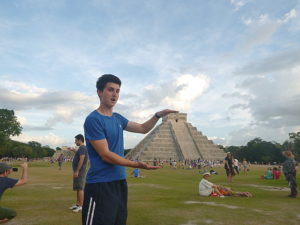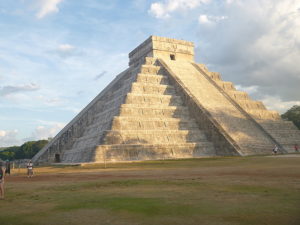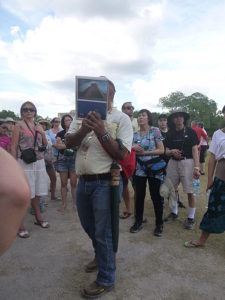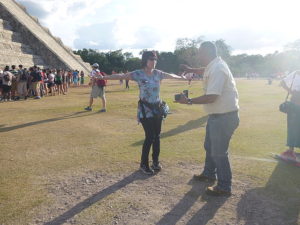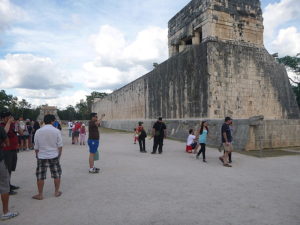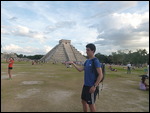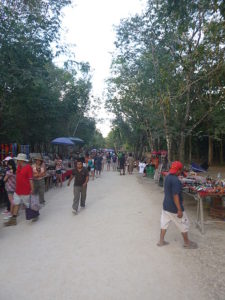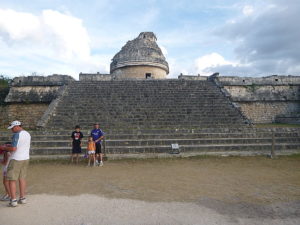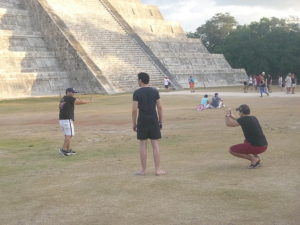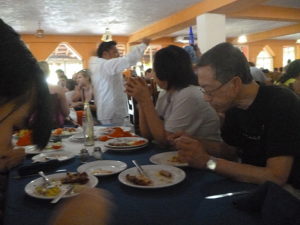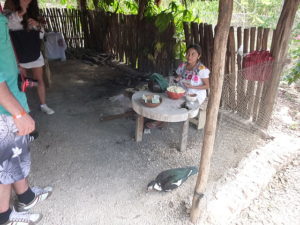Chichen Itza was a dominant city in Ancient Mayan times. In 2007, it became on of the New Seven Wonders of the World, and nearly six years later it welcomed a (nother) coachload of tourists. Including myself.
The whole day was pretty thorough, and covered more than just a walk around the ancient city. The tour included a cenote visit, stop off in a Mayan town, and a detailed commentary on the way of the Maya from our trusted guide Ruben.
It began in the morning, with about 400 people descending upon a big Cancun shopping mall to pick up tickets. They then shuffled us to our shuttle bus to make the 2.5 hour bus trip inland to Chitchen Itza. I drew the short straw as Mr Dursley came and parked himself next to me. Ruben then had us introduce ourselves to the bus.
Though an arid way to pass the time, we did learn that my neighbour was a newlywed, and his bride was at the back of the coach as they were the last ones on, and seats had filled up. Keen to avoid slow death of suffocation, I offered to swap with Mrs Dursley (considerably heftier than Aunt Petunia..) so the happy couple could be reunited.
At the toll road stop we made the switch, and I left the pair firmly wedged in their seats as I walked to the rear of the bus to enjoy the possibility of extending my limbs for the remainder of the journey.
The first stop of the day was a cenote. It was the largest one I’ve visited so far, and the water had a “refreshing” temperature when it came to swim time. The site was fully decked out for tourists, with Mayans dressed up, playing music, and even making tortillas in the traditional Mayan way. Draw comparison from the photo in this blog with that in 6.3.2.
Back on the bus, the next stop was a Mayan community that survives, in part, through hosting a large artisan market of traditional Mayan crafts. And next door is the all-you-can-eat buffet.
I find these places on the whole positive. Though there is an obvious erosion of authentic culture, the Mayans have only survived this long through adaptation. If flogging wall paintings, hand-carved pieces of art, and skull replicas to a willing public (including yours truly) is a means of income and allows them to preserve their customs, then I am all for it.
During lunch, the waiters conducted a dance involving balancing beer bottles on their heads. Though Ruben’s knowledge of Mayan traditions was comprehensive, we couldn’t quite place what era that one was from…
Fully fed it was back to the bus for the last leg up to the Maya city. Once parked, and through the hoards, we were passed over to Jose for an explanation and tour of the Ruins.
The city was fascinating, and the buildings have been restored/ preserved in excellent condition. Between them, Ruben and Jose pearled out a number of Fun Facts for readers to add to their list on the Mayans.
Again, this is more so I don’t forget them, so feel free to skip past:
Fun Fact #22 – the first recorded ruler of Chitchen Itza was female
Fun Fact #23 – the basic demographic in most Mayan cities was 90:8:2 – working class: intellectual: super-intellectual.
Fun Fact #24 – as stated elsewhere, Mayans had an incredible understanding of cosmology. However it was only the super-intellectuals who held this knowledge. Once they worked out the date of an eclipse, say, they would announce it to the city, and the mere commoners could only assume that their knowledge was acquired by otherworldly means (i.e. they were thought of as Gods)
Fun Fact #25 – the Mayans therefore ruled by intellect, rather than brute force. That said, around the time of 900AD Chitchen Itza made an alliance with the “Tolteka” civilisation who were warriors by nature (well, nurture) to help keep order
Fun Fact #26 – a Toltekan warrior’s training began aged seven. It was ingrained in them that 1) you are immortal 2) you are half man, half beast 3) you will learn how to survive. Aged 15, their “entrance test” was a mission to bring an enemy back to the barracks not dead, but alive Fun
Fact #27 – the Ball Court at Chitchen Itza is slightly different to others we have seen as it has hoops for where the ball must go through
Fun Fact #28 – the game played here was done so by senior militia. 7 men on each side, using only knees, hips, elbows and head must aim to get the rubber ball (size 3 football) through one of the hoops. They often lasted days
Fun Fact #29 – the game was used to prevent war. Instead of doing battle, each side put forward their high-ranking officers (who had WWE-esque entrances/ apparel apparently) to have a game and decide the winner. In the process saving thousands of lives
Fun Fact #30 – inscriptions at the base of the court told stories of victories between teams (and the subsequent heads being torn off etc)
Fun Fact #31 – high members of society sat in the equivalent of a Royal Box. Others who were allowed would sit on the top of the walls
Fun Fact #32 – war memorials had images of the fallen carved in stone. Enemy heads were on sticks above them
Fun Fact #33 – human sacrifices took place on the Main temple. Look away now if you don’t want to read the description. The alive enemy would be laid across a ceremonial table with four men holding an ankle or wrist. When the sign was given from the Chief (dressed with an Eagle headdress) the men would pull down, breaking the back. The Eagle would then thrust a dagger deep into the chest and with surgeon-like precision remove the heart from the victim which remained pumping for 14 seconds. These offerings to the Sun Gods would often happen daily
Fun Fact #34 – when the ‘Gods’ came to speak to the masses (CI had a population of c. 100, 000) they could do so at a normal volume from the top of the temple, such were the acoustics
Fun Fact #35 – Chitchen Itza was ‘found’ by an American and a Brit. The Englishman had a local Mayan carry him around on his back for two weeks as they explored the jungle
Fun Fact #36 – the reason so much was known is because Spanish conquistadors lived among the Maya for sometimes up to a year, and they transcribed their experience
Fun Fact #37 – the reason not more is known is because the Spanish order the destruction of all Mayan books. Huge fires incinerated hundreds of years of human knowledge. Only three texts are known to remain in the entire world.
Fun Fact #38 – modern-day Maya prefer to preserve their culture and physical features (short stature/ straight black hair/ good teeth etc.) by not marrying outside of their race
Fun Fact #39 – the temples and buildings would’ve looked different in Ancient times. They were not the bare stone we see today, but were ‘plastered over’ and had bright colours depicting prosperity. Remnants of some of these colours are still visible today
Along the way, Jose clocked on to the reason most of us were here… to get a Decent Profile Pic (or DPP).
He showed us spots to get all the great poses that friends back home would enjoy. Smart Jose. I even spotted a few others trying to get innovative.
Explored some more of the city (we had a tour of ‘new town’, developed after the older structures on the outskirts). Although with only 10% uncovered, I don’t know how they can be so certain of these claims. Nonetheless saw an impressive Observatory and other, older temples.
There’s nothing much to report on the journey home. Chatted with my (new) neighbour who expressed more than a passing interest in visiting England. I drew up a list of places outside London he and his family should go to. Was quite fun taking on a tourist perspective of back home.
15 hours after departing, I returned to the hostel and got some shut-eye. The day was my last excursion of Central America.
